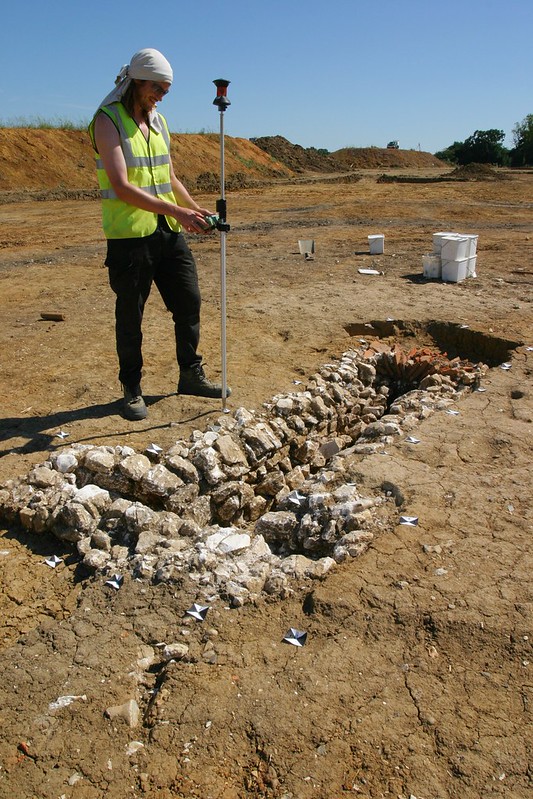Yes, corn-dryers! There, I’ve said it, and there’s no going back.
Familiarity, as the old saw goes, breeds contempt – or at least indifference. I think that sometimes that holds true for archaeology as much as anything else: there are certain topics that feel done, perhaps even overdone. Topics with which you feel you’ve spent as much time as is useful. Topics which you probably encountered in your youth, and feel – at best – nostalgic about, but not nostalgic enough to delve into.
And so, corn-dryers. If, like me, you visited Romano-British villas as a child, you’ve probably seen the foundations of a classic Romano-British corn-dryer: big, stone-built, T-shaped and – let’s be honest – winning no beauty contests. Very possibly, it was the boring adjunct to a tour of the hypocausts and mosaic-flaunting bath chambers. By comparison, a bit dry.
Here’s one courtesy of Wessex Archaeology, posted under the Creative Commons licence:
Even for the student/researcher in British archaeology, corn-dryer literature has been rather quiet for a few decades (full references provided at the end of this blog post). In the 1970’s, we find Rickett’s undergraduate dissertation on “post-Roman and medieval drying kilns” – unpublished but still at Cardiff University library – and a chapter in Morris’ Agricultural Buildings in Roman Britain. There was also a practical experiment by the late Peter Reynolds and co. at Butser Ancient Farm, involving the reconstruction and operation of a Roman-style corn-drying structure, whose results were usefully published. In the 1980’s, we find a paper by Monk on post-Roman drying kilns, and one by van der Veen on the charred plant remains from Romano-British corn-driers. All very good stuff indeed – but not much else in last 25 years, although hopefully a little paper of my own will find its way into print soon (watch this space).
By contrast, Irish archaeology has benefited from some very good recent publications by Monk and his colleagues. Surely progress can be made in British archaeology too? The Roman-period evidence alone must be worth another look.
So I’m taking the plunge. No research grant (yet), no institutional setting (yet), but enough enthusiasm to give it a bash in my spare time. It might not be fashionable. It might generate more interest if I called the project something like, “Being Human, Being Grain: concepts of cereality in antiquity (a phenomenological approach)”. But really, it’s about the corn-dryers, those chunky items of agricultural technology that deserve another look – and a few blog posts too. I’m interested in shapes, sizes, dates and distributions; contents, contexts, and composition. I’ll be stacking up evidence and looking for patterns, particularly in terms of form and function (I am an archaeologist, dash it).
Here goes.
MJM.
Select References (with apologies for omissions of obvious key texts that have slipped through my sieve-like mind)
Goodchild, R.G. (1943). “T-shaped Corn-drying Ovens in Roman Britain” The Antiquaries Journal 23, pp. 148–153.
Monk, M. & Power, O. (2012). “More than a grain of truth from a rash of corn-drying kilns?” Archaeology Ireland 26 (100), pp. 38–41.
Monk, M.A. (1981). “Post-Roman Drying Kilns and the Problem of Function: a preliminary statement”, in Ó Corráin, D. ed. Irish Antiquity. Essays and Studies presented to Professor M.J. O’Kelly. (Cork: Tower Books), pp. 216–230.
Monk, M.A. & Kelleher, E. (2005). “An Assessment of the Archaeological Evidence for Irish Corn-Drying Kilns in the Light of the Results of Archaeological Experiments and Archaeobotanical Studies” The Journal of Irish Archaeology 14, pp. 77–114.
Morris, P. (1979). Agricultural Buildings in Roman Britain. Hands, A. R. & Walker, D. R. eds. (Oxford: British Archaeological Reports).
Reynolds, P.J. & Langley, J.K. (1979). “Romano-British Corn-Drying Oven: An Experiment” The Archaeological Journal 136, pp. 27–42.
Rickett, R.J. (1975). Post-Roman and Medieval Drying Kilns. (unpublished BA thesis – University College, Cardiff).
Van der Veen, M. (1989). “Charred Grain Assemblages from Roman-Period Corn Driers in Britain” The Archaeological Journal 146, pp. 302–319.

You’ll get support more easily if you somehow link it to Global-Warming-We’re-All-Going- To-Roast -In-Hell.
It might generate more interest if I called the project something like, “Being Human, Being Grain: concepts of cereality in antiquity (a phenomenological approach)”.
I literally laughed out loud at this. Sad that it is true as well as hilarious.